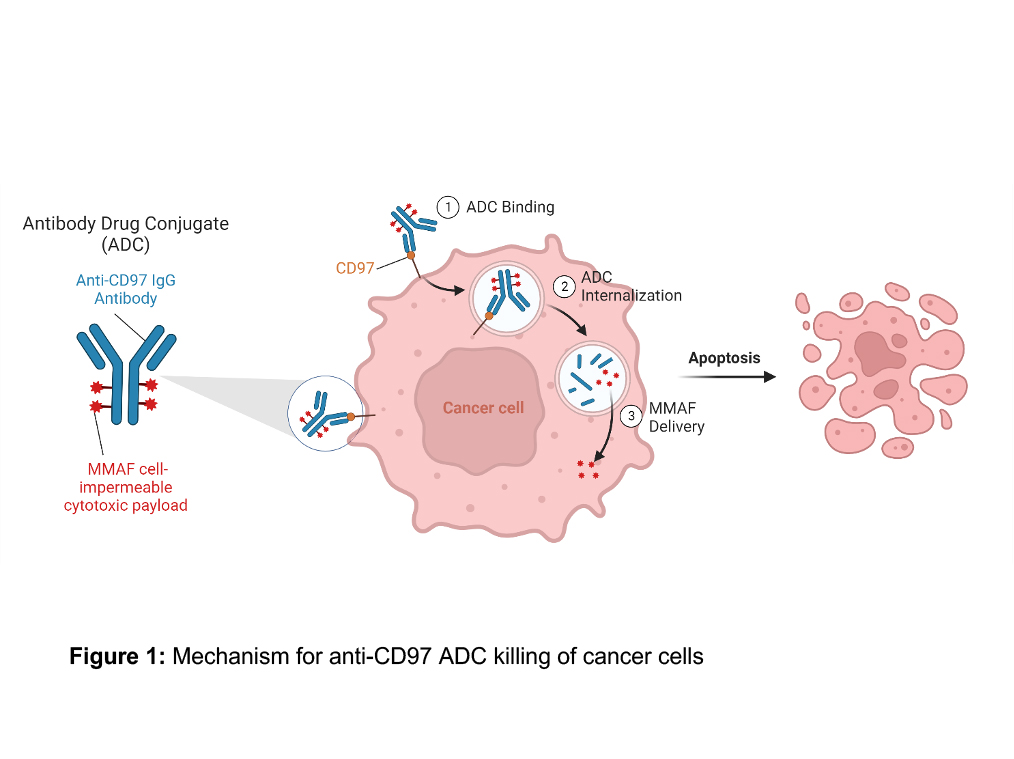Anti-CD97 Antibody-Drug Conjugates for the Treatment of AML and GBM
Innovative, efficacious, and improved treatment option for Acute Myeloid Leukemia (AML) and Glioblastoma (GBM)

Technology
The NYU investigators have developed a human antibody selective to CD97 (Cluster of Differentiation 97, a.k.a., adhesion G protein-coupled receptor E5 (ADGRE5)) and demonstrated its cell-killing efficacy in vitro as an antibody-drug conjugate (ADC) in the context of AML and GBM. Published proof-of-concept studies (Ravn-Boess et al bioRxiv 2023) show that anti-CD97 antibodies bind multiple epitopes of CD97 with high affinity (low nano-molar KD) and specificity (no off-target binding to its ERM2 homolog). The investigators identified an antibody candidate that was efficiently internalized, suggesting its applicability for cytotoxic payload delivery as an ADC. When conjugated to monomethyl auristatin F (MMAF), a cell-impermeable cytoskeletal polymerization blocker commonly used for ADC, this anti-CD97 ADC showed a lower lethal dose (LD50) to patient-derived GBM cultures (PDGCs) relative to normal brain cells (non-neoplastic human astrocytes “NHAs” and neural stem cell “NSC”). Similarly, in the context of AML (unpublished work), this ADC showed potent (1.0 nM EC50) and dose-dependent AML cell killing that was correlated with CD97 cell surface expression levels. A schematic illustrating the mechanism for anti-CD97 ADC killing of cancer cells is shown in Figure 1. Taken together, these findings establish CD97 as a promising therapeutic target for AML and GBM, and support the anti-CD97 ADC as a candidate for therapeutic development.
Background
AML and GBM have limited treatment options and poor survival rates. For AML, despite approved targeted therapies, the 5-year relative survival rate for afflicted individuals ≥20 years of age is only 28%. Similarly, for GBM, where the current treatment regimen involves neurosurgical tumor resection and chemoradiotherapy, the median survival time is approximately 15 months. CD97 is a promising target in AML and GBM for therapeutic development. A strong body of scientific evidence links this adhesion G protein-coupled receptor (aGPCR) to both diseases. In the context of AML, CD97 is involved in tumor growth, survival, and differentiation, and is used as an independent predictor of disease-free and overall survival (Martin et al. JEM 2019). Moreover, it is not required for hematopoietic stem cell function, suggesting low toxicity for CD97-targeting therapeutics. With respect to GBM, CD97 is implicated in cellular proliferation, brain invasion, and tumor metabolism, and its mechanisms of activation and signaling have been elucidated. Additionally, in GBM, CD97 possesses a very favorable differential expression profile: high expression in GBM cells and no expression in normal brain tissue and NSCs. Altogether, CD97 represents a promising target in AML and GBM.
Next Development Steps:
- Further target validation: Determination of the minimum level of CD97 expression required for cytotoxicity
- In vivo mouse efficacy studies for AML and GBM.
- Defining therapeutic window
Applications
Therapeutic treatment of AML, GBM, and other cancer types with favorable CD97 expression profiles
Advantages
- Mechanisms of activation and signaling have already been characterized
- Desired expression profile: CD97 is more highly expressed on AML and GBM malignant cells relative to normal healthy cells; hematopoietic and neural stem cells do not express CD97.
- Ubiquitous tumor subtype expression: CD97 is expressed in all GBM subtypes and is one of the most commonly expressed AML antigens expressed across all genetic subtypes, as well as being expressed in several non-hematopoietic malignancies including breast, thyroid, gastric, and prostate carcinoma.
- Favorable attributes of candidate ADC: IgG-formatted; human variable domain sequences; nanomolar target affinity; and high selectivity
Intellectual Property
NYU has filed a U.S. non-provisional patent application covering the antibody-drug conjugate compositions and their method of use.
-
expand_more mode_edit Authors (3)Shohei Koide, PhDChristopher Park, MD, PhDDimitris Placantonakis, MD, PhD
-
expand_more library_books References (1)
- Shohei Koide, Christopher Y. Park, Dimitris G. Placantonakis, et al. (2023), The expression profile and tumorigenic mechanisms of CD97 (ADGRE5) in glioblastoma render it a targetable vulnerability
-
expand_more cloud_download Supporting documents (2)Product brochureAnti-CD97 Antibody-Drug Conjugates for the Treatment of AML and GBM.pdfMarketing BriefNYU - Anti-CD97 antibody-drug conjugates - Marketing Brief - KOI01-16.pdf (100 KB)